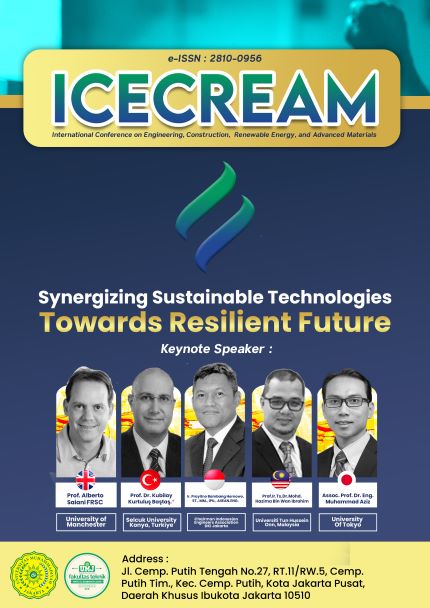Tropical Savanna Climate Zone Of East Nusa Tenggara, Indonesia
Abstract
The most frequently used climate classification map is that of Wladimir Köppen, Köppen is a plant scientist and realised that plants are indicators for many climatic elements. Each zone has its own characteristics in terms of architectural form. Climate zones themselves are found in various countries, including the climate zone in Indonesia, a country that is well known as a tropical one, a country that only has two seasons : the dry and the rainy seasons, so the Climate Zone system exists also in Indonesia. The traditional houses in the tropical savanna zone that will be discussed are traditional houses located in Eastern Indonesia. The discussion is related to cosmology, building form, and the influence of climate on traditional houses. The method used in this paper is qualitative by obtaining literature study data from various journals. The purpose of the discussion in this paper is to add some information to the scientific literature bertaining to traditional houses in the tropical savanna climate zone of east nusa tenggara according to the Koppen Classification System.Keywords: Architecture, Climate, Traditional HousesReferences
Andre Mariano Dos Santos Belo,
Maria Immaculata Ririk Winandari.
Arsitekur Uma Lulik Fuiloro,
Lospalos Kota, Timor Leste.
ejournal.undip.ac.id
Arif Ashari. 2017. KLASIFIKASI
IKLIM. Yogyakarta
Eugenius Pradipto, Kartika Tristanto.
Ketahanan sistem struktur
bangunan terhadap angin studi kasus :
Mbaru Niang di Desa Wae Rebo,
Kabupaten Manggarai, NTT. Jurnal
Arsitektur Pendapa. 4, 4-5.
Fisher R., Bobanuba W. E.,
Rawambaku A., Hill G. J. & Russell-
Smith J. 2006 “Remote Sensing of
Fire Regimes in Semi-Arid Nusa
Tenggara Timur, Eastern Indonesia:
Current Patterns, Future Prospects”.
International Journal of Wildland Fire
, 307-17.
Monk K. A., De Fretes Y.,
Reksodihardjo-Lilley & Gayatri. 2000.
Ekologi Nusa Tenggara dan Maluku.
Jakarta: Prenhallindo
Russell-Smith J. & Edwards A. C.
(2006) Seasonality and fire severity in
savanna landscapes of monsoonal
northern Australia. International
Journal of Wildland Fire 15, 541-50.
Tacconi L. & Ruchiat Y. 2006.
“Livelihoods, Fire, and Policy in
Eastern Indonesia”. Singapore Journal
of Tropical Geography 27, 67-81.
Tjong Mei Lang. 2015. Rumah
Tradisional Suku Atoni: Sonaf Nis
None. DIMENSI INTERIOR,
VOL.13, NO. 1, JUNI 2015: 21-33
Tupor, M. (2021) survey uma lulik
Whitten T., Soeriaatmadja R. E. &
Afiff S. A. 1996. The Ecology of
Indonesia Series Volume II: The
Ecology of Java and Bali.Hongkong:
Periplus.
Syarif Shidqi Rabbani, Arief Bachtiar,
Riko Setya Wijaya. 2021.
Optimalisasi pengembangan
pariwisata dan potensi ekonomi lokal
di kampung wae rebo nusa tenggara
timur. Jurnal Syntax Admiration.
Jawa Timur
Belo, A.M.D.S. (2021) Karakteristik
Uma Lulik di Municipio Lautem
Timor-Leste. Thesis Magister
Arsitektur. Universitas Trisakti
https://www.gadizalombok.com/2019/
/23/keunikan-bale-lumbung-rumah-
penyimpanan-hasil-panen-suku-sasak/
https://inakoran.com/mengenal-
rumah-bale-lumbung-di-ntb/p40293
https://www.daerahkita.com/artikel/31
/rumah-bale-tempat-tinggal-
tradisional-suku-sasak-di-lombok
https://arsitektur12ruangdalam50mulia
na.wordpress.com/2015/05/08/mbaru-
niang-rumah-tradisional-suku-wae-
rebo-pulau-flores/
https://www.hdesignideas.com/2013/1
/mbaru-niang-rumah-adat-di-pulau-
flores.html
Putri, 2022. Mengenal 5 Klasifikasi
Iklim Koppen.
https://www.kompas.com/skola/read/2
/10/03/120000969/mengenal-5-
klasifikasi-iklim-koppen.
https://p2k.stekom.ac.id/ensiklopedia/
Klasifikasi_iklim_K%C3%B6ppen

